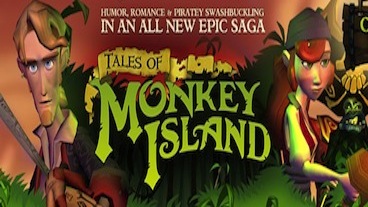
Tales of Monkey Island Episode 1 :Launch of the Screaming Narwhal







Hooray! Monkey Island is back. If you are a Monkey Island fan you just have to get on board. Also recently released was an enhanced remake of the Secret of Monkey Island (SOMI), which was originally released in 1990 by LucasArts. The enhanced version uses animation similar to that used in Tales of Monkey Island (TOMI). If these games do well, we will get more Monkey Island games. Please support the release of both games so that this will happen. And don’t just support the games for their past – consider the future of intelligent gaming, with clever writing and even more interesting plot and character development.
Monkey Island was inspired by Walt Disney’s Pirates of the Caribbean (POTC) ride in Disneyland in Anaheim, California. The game logically followed the premise that you could get off inside the POTC ride and enter the pirate world. Long before the idea to make a POTC movie, the idea was alive in the mind of Monkey Island creator Ron Gilbert. The Pirates of the Caribbean movies included several homages to the game. For example, in the beginning one of the POTC movies, Jack Sparrow was floating on the ocean in a coffin. At the beginning of one of the Monkey Island games, Guybrush Threepwood was floating on the ocean in a coffin.
Darrell Rodriguez, a then-new president of Lucas Arts, who owns the rights to Monkey Island, gave Telltale Games the go-ahead to produce the new games. The Launch of the Screaming Narwhal is episode one in a five-episode serial presented in the episodic gaming style perfected by Telltale Games. A new chapter will be released once a month starting in July, 2009. The episodes or chapters each encompass part of the entire game. David Grossman, the designer of the game, brainstormed with original creator Ron Gilbert, and says that the entire game – all five episodes – does not contain the same amount of gameplay typical of an entire Monkey Island game. There were four games prior to this new Tales of Monkey Island (TOMI) episodic game. Ron Gilbert’s original game, The Secret of Monkey Island (SOMI), was released by Lucas in 1990. Secret was followed quickly by LeChuck’s Revenge (LCR) in 1991, The Curse of Monkey Island (COMI) in 1997 and Escape from Monkey Island (EFMI) in 2000.
The game play philosophy is to let the player explore the game world and try all of the available options without fear of dying. Ron Gilbert set the tone with this game play development with the rubber tree gag used in SOMI. While walking along a path in the hills on the island, Guybrush falls off the cliff, similar to many death scenes in the Sierra Online games of the time (specifically King’s Quest). In the Sierra games you have to reboot the game and the computer and restore the last save game. In SOMI, you get the normal Sierra-like death animation, which says, “Guybrush died; please reboot your computer;” you reload your last save and the game locks up, just like in the Sierra games. After waiting, the computer came back to life and said, “we were only kidding” – Guybrush actually landed on a rubber tree, which bounced him right back onto the path where he fell off. In later Sierra games, you still would die, but you would be restored to a save game that was automatically saved just before you died, eliminating the need to reboot the computer and the game and restore the last manual save. The last manual save might have put you hours back into the game if you had forgotten to save often and save smart.
The plot involves the original villain from the first four games, the evil pirate LeChuck, who still has a fondness for kidnapping Elaine Marley, Guybrush’s sweetheart from the previous four games. The game player takes the role of Guybrush in saving Elaine and thwarting LeChuck – and somewhere along the way he has to deal with a pirate curse.
Several years after EFMI, Guybrush is stranded on Flotsam Island after a battle with LeChuck and a somehow not right voodoo sword recipe. Elaine, LeChuck, and Guybrush are involved in a little explosion, and Guybrush’s hand gets the voodoo curse of LeChuck. LeChuck becomes human and begins wooing Elaine. Meanwhile Guybrush has to stop the winds that prevent the launching of the one ship on Flotsam and save the hapless pirates there from the evil experiments of Marquis deSinge.
Typical of a game developed after the demise of the Graphic Animated Adventure Game (GAAG), the development of TOMI was plagued with legal wrangling over Ron Gilbert’s involvement (he is now working for another game development house). Steve Purcell, the Sam and Max creator, returns to reprise his role as the SOMI box designer by designing the limited edition slipcover artwork. Michael Land, the SOMI music composer, returns to compose the TOMI soundtrack. The voice actors all return, with the notable exception of Earl Boen, who was the voice of LeChuck in the original series.
The dulcet tones of Dominic Amato voice Guybrush in TOMI as they did in COMI. Alexandra Boyd, who voiced Elaine Marley in COMI, also returns in TOMI. Telltale uses a lip-sync system to make the voice animations and the characters look more believable.
Some other game reviewers, specifically Eurogamer, have criticized the release for having poor presentation of personality on the minor acting role animation characters, while 1UP.com praised Guybrush’s character animation as being “the most convincingly expressive Telltale character yet.” IGN wrongly feels that the plot has no lasting appeal beyond one run-through.
The TOMI puzzles resemble the twisted puzzles from Guybrush’s past adventures. Guybrush is prone to messing things up, and he often has to find alternative solutions that have surprising and not often wanted results. Most puzzles involve using the vast inventory of items acquired by finding and picking up everything not nailed down, including everyone else’s possessions, which you steal right in front of them as you rifle through the drawers, chests, and total contents of their home, store, bar, etc., while the character remains blissfully oblivious to your larceny. You can also combine items to make other items in pure SOMI fashion.
The Inventory is activated on the right side of the screen by moving your cursor there. The inventory has two windows to combine items from the inventory and allows you to use the items with other items in the background art environment. The inventory was a bit klutzy to get used to but in a few seconds you will get the hang of it.
Getting around in TOMI is somewhat different than the original point-and-click-to-move interface. The player can use the AWSD key combination to move or “hold and drag the mouse in the desired direction.” There is also a quick-move automap system that in certain locations switches to the entire Flotsam Island, allowing the player to click where he wants Guybrush to quick-move. I initially found getting around a bit awkward, but eventually got the hang of it.
The game mechanics allow for save, load, quit, graphics, hint frequency, pop-up text, subtitles, and audio. Accessed through “settings” are the audio (music, voice and sounds (sound effects) volume), graphics (resolution, full screen vs window, and video quality (1 to 9), and gameplay (hint frequency, pop up text, and subtitles). Unfortunately, when trying to save to a blank save game, the game will often tell you that you cannot save your game at this point, or here or now. In my humble opinion, there should be no place or time when you cannot save the game.
Conclusion: I found the game as refreshing as a bucket of ice water on a sweltering evening. TOMI gives me hope that American game companies have finally seen the light that the European companies never lost sight of: specifically, that the graphic adventure game genre is alive and well, in spite of the raft of violence and lack of imagination in most of the shooter type games that abound in the American market. The animation and still art is better. The story is top notch. The music and voice work is as good as it always was (excellent).
|
Final Grade: A |
The Tales of Monkey Island details
Price $34.95 for the entire 5 episode series
Developer(s) Telltale Games
Distributor(s) Telltale Games. WiiWare, Steam
Designer(s) Dave Grossman
Writer(s) Mark Darin, Michael Stemmle, Sean Vanaman
Composer(s) Michael Land
Series Monkey Island
Platform(s) Windows, Wii
Release date(s) starting July 7, 2009 (PC), Summer 2009 (WiiWare)
Genre(s) Graphic adventure
Mode(s) Single-player
Rating(s) ESRB: Everyone 10+ PEGI: 12+
Media Download, DVD
System requirements 2.0 GHz CPU 512 MB RAM 64 MB video card[1]
Input methods Keyboard and mouse,Wii Remote, Wii Nunchuk
References:
Secret of Monkey Island, with Amanda L. Giovetti, Current Notes, volume 11, number
9, November, 1991, pg. 56.
Secret of Monkey Island: Keys to the Kingdom, Questbusters, volume 8, number 7,
July, 1991, pg. 14.
Secret of Monkey Island: Walkthrough, Questbusters, volume 8, number 8, August,
1991, pg. 10-12.
Curse of Monkey Island Review, Al Giovetti, The Computer Show, volume 2, number 1,
1997 http://www.thecomputershow.com/computershow/reviews/curseofmonkeyisland.htm
From
http://www.thecomputershow.com/computershow/biographies/algiovettibibliography1.htm
http://www.thecomputershow.com/computershow/news/rongilbertcavedog.htm
http://www.thecomputershow.com/computershow/walkthroughs/curseofmonkeyislewalk2.htm
http://www.thecomputershow.com/computershow/walkthroughs/monkeyisland4walk.htm
http://www.thecomputershow.com/computershow/walkthroughs/secretofmonkeyisland2walk.htm
http://www.thecomputershow.com/computershow/walkthroughs/curseofmonkeyislewalk.htm

Leave a Reply